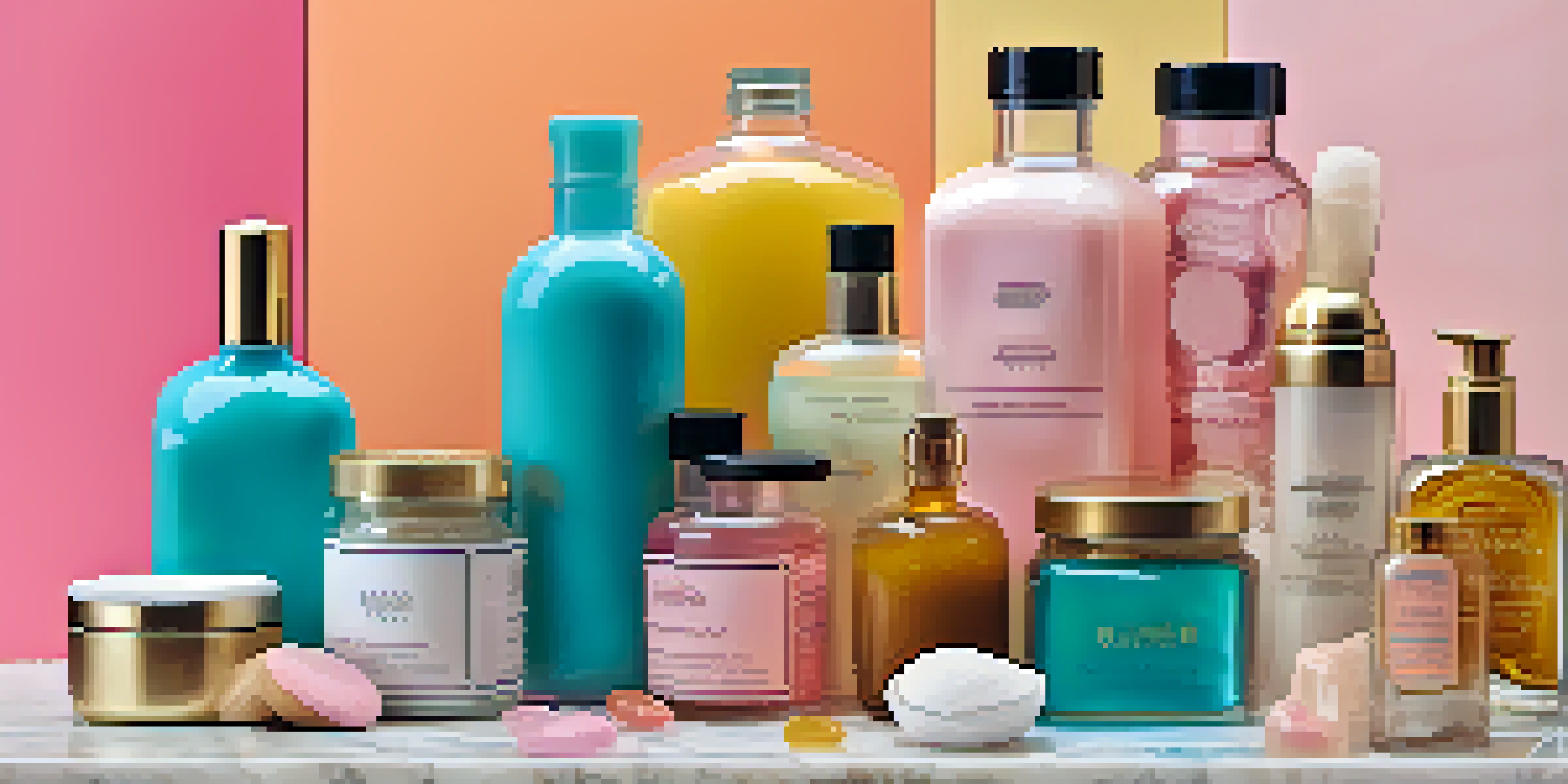Comparing Synthetic vs. Plant-Derived Beauty Ingredients

Understanding Synthetic Beauty Ingredients
Synthetic beauty ingredients are man-made compounds created in laboratories. They often mimic natural substances but can be more stable and effective. For instance, silicones are synthetic ingredients that provide a silky feel and shine, making them popular in hair and skin products.
Nature does not hurry, yet everything is accomplished.
One advantage of synthetic ingredients is their consistency. Unlike natural ingredients, which can vary based on season and sourcing, synthetic compounds offer reliable performance. This predictability is crucial for brands aiming to deliver consistent results in their products.
However, there are concerns about synthetic ingredients, particularly regarding skin sensitivity and allergies. Some individuals may react negatively to certain chemicals, making it important for consumers to read labels carefully and choose products that suit their skin type.
What Are Plant-Derived Beauty Ingredients?
Plant-derived beauty ingredients come from natural sources like flowers, fruits, and herbs. These ingredients are often celebrated for their holistic benefits and gentle nature. For example, aloe vera is a popular plant-derived ingredient known for its soothing and hydrating properties.

One of the primary appeals of plant-derived ingredients is their perceived safety. Many consumers gravitate towards these products, believing they are free from harsh chemicals and better for the environment. This trend has spurred the rise of clean beauty brands that prioritize natural formulations.
Synthetic vs. Plant-Derived Efficacy
Synthetic ingredients often provide targeted effectiveness, while plant-derived options offer a broader range of holistic benefits.
Nevertheless, plant-derived ingredients can also pose challenges. They may have shorter shelf lives and can vary in potency due to environmental factors. As a result, brands must ensure proper sourcing and extraction methods to maintain efficacy.
Comparing Efficacy: Synthetic vs. Plant-Derived
Efficacy is a key consideration when comparing synthetic and plant-derived ingredients. Synthetic ingredients are often engineered for specific purposes, which can lead to highly effective formulas. For instance, retinoids, a synthetic derivative of vitamin A, are renowned for their anti-aging properties.
The greatest threat to our planet is the belief that someone else will save it.
On the other hand, plant-derived ingredients may offer a broader range of benefits due to their complex chemical compositions. For example, essential oils can provide both aromatic and therapeutic effects, enhancing the overall experience of using beauty products.
Ultimately, the most effective choice depends on individual skin needs and concerns. While some may benefit from the precision of synthetic ingredients, others may find the nurturing qualities of plant-derived options more suitable.
Environmental Impact of Synthetic Ingredients
The production of synthetic beauty ingredients can have a significant environmental footprint. Many synthetic compounds are derived from petrochemicals, contributing to pollution and resource depletion. This has raised awareness about the sustainability of beauty products and their long-term effects on the planet.
Additionally, the manufacturing processes involved in creating synthetic ingredients often require energy-intensive procedures. This not only impacts the environment but can also lead to higher costs for consumers. As a result, many brands are exploring greener alternatives to synthetic formulations.
Environmental Impact Matters
The production of synthetic ingredients can harm the environment, but sustainable practices in both synthetic and plant-derived sourcing are essential.
However, it's worth noting that not all synthetic ingredients are harmful. Some companies are committed to sustainable practices and use eco-friendly methods to produce their products. This shift indicates a growing awareness within the industry about the need for more responsible sourcing and production.
Sustainability of Plant-Derived Ingredients
Plant-derived ingredients often tout their sustainability, as they come from renewable resources. Cultivating plants for beauty products can support biodiversity and promote ecological health. For instance, many brands source ingredients from sustainable farms, ensuring minimal environmental impact.
However, the cultivation of certain plants can also lead to deforestation and habitat loss if not managed properly. It's crucial for consumers to research brands and their sourcing practices to ensure they align with sustainable values. Transparency in ingredient sourcing is becoming increasingly important in the beauty industry.
Some brands even participate in fair-trade practices, ensuring that farmers receive fair compensation for their crops. This not only supports local economies but also encourages ethical cultivation methods, helping to preserve the planet for future generations.
Skin Sensitivity and Allergies: A Comparison
When it comes to skin sensitivity, plant-derived ingredients often win points for being gentler on the skin. Many natural ingredients are loaded with antioxidants and vitamins, which can nourish and soothe without causing irritation. For example, chamomile extract is known for its calming properties, making it ideal for sensitive skin types.
Conversely, synthetic ingredients can sometimes trigger allergic reactions in certain individuals. Chemicals like sulfates and parabens, often found in conventional beauty products, have been associated with skin irritations. This has led to an increase in demand for hypoallergenic products that cater to sensitive skin.
Future of Beauty: A Hybrid Approach
The beauty industry is moving towards a blend of synthetic and plant-derived ingredients to create effective and safe products for diverse skin needs.
That said, not all synthetic ingredients are harmful, and some are even formulated specifically for sensitive skin. Brands are increasingly focusing on creating products that minimize irritation while maximizing efficacy, offering options that cater to a wide range of skin types.
The Future of Beauty: Blending Both Worlds
The beauty industry is evolving, with many brands recognizing the benefits of combining synthetic and plant-derived ingredients. This hybrid approach allows formulators to leverage the strengths of both types, creating innovative products that cater to diverse consumer needs. For instance, a moisturizer might blend hyaluronic acid (synthetic) with shea butter (plant-derived) for hydration and nourishment.
This trend reflects a growing consumer desire for transparency and effectiveness, as shoppers increasingly seek products that deliver results without compromising on safety. By harnessing the best of both worlds, brands can create formulations that are both powerful and gentle.

As we look to the future of beauty, it's clear that education will play a vital role. Consumers will continue to demand clarity about ingredient sourcing and efficacy. Those brands that prioritize transparency and sustainability will likely thrive in this ever-changing landscape.